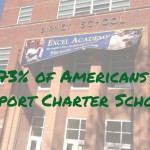
The following are answers to frequently asked questions (FAQs) regarding charter schools and what they mean for students, educators, schools and communities. The answers to these FAQs are intended to provide only an introductory overview of key issues. Links are provided to take you to areas with additional information.
What are charter schools?
Charter schools are public schools, open by choice, free from most rules and regulations that hamper traditional public schools and held accountable for results.
Since 1991, when charter schools were first established in Minnesota, the principle has remained the same — increased operational autonomy in exchange for increased accountability for outcomes. This freedom to innovate allows academically excellent charter schools to flourish.
As of 2022, there were more than 7,800 charter schools across the country with more than 3.7 million students, with demand higher everywhere they are located. Forty-six states, including Washington, D.C. have charter school laws. West Virginia enacted the most recent law in 2019. All charter laws are not created equal, however, and in fact, many are so flawed that they allow for only minimal opportunity for parents.
For a complete assessment and explanation of charter school laws and where each state ranks, see the Parent Power! Index and National Charter School Laws Rankings & Scorecard- 2022.
How Do Charter Schools Differ from Traditional District Public Schools?
Charter schools operate on three basic principles:
Choice: Charter schools give families an opportunity to pick the school most suitable for their child’s educational well-being. Teachers choose to create and work at schools where they can directly shape the learning environment for their students and themselves in innovative ways. Likewise, charter authorizers choose to sponsor schools that are likely to best serve the needs of the students in a particular community.
Innovation: One of the reasons parents and students seek charters is because, when they work, they offer options that are distinct from those found in most traditional school districts. Charters have the flexibility to innovate in many ways: from developing unique approaches to teacher training to pioneering tools for personalized learning, many innovations that are now accepted as common were born in the charter sector.
Accountability: Charter schools must meet the student achievement goals established by their charter contracts and must also meet rigorous fiscal and managerial standards. If a charter school cannot perform up to the established standards, it will be closed.
Freedom: While charter schools must adhere to the same major laws and regulations as all other public schools, they are freed from the red tape that often diverts a school’s energy and resources away from educational excellence. Instead of constantly jumping through procedural hoops, charter school leaders can focus on setting and reaching high academic standards for their students.
Some charter school programs focus on the basics — reading, writing, and the traditional school subjects with which some students struggle. Other schools have special arts or music programs. Some charters look just like traditional public schools, and some serve a particular community. Some are dropout prevention programs, adult education programs, online programs, charters that serve day care needs, and charters that work with children who want to go to college.
What does Charter School Enrollment Look Like?
There are more than 7,800 charter schools across the country with more than 3.7 million students attending, with demand higher everywhere they are located. Over time, demand for charters has skyrocketed, despite setbacks deriving from weak charter school policies, overregulation, and false perceptions of charter schools promulgated by opponents of school choice.
Over one million students currently sit on charter school waitlists– because many states place caps on the number of charter schools that can exist, charter schools often have more applicants than spaces available. When this happens, charters admit students via lotteries. Lotteries ensure that students are randomly selected and, in this way, that charter schools cannot “cream” students, especially those that may be considered “easier” to educate, or who may be better equipped to perform well academically. Unfortunately, however, in places where demand for charter schools is very high, there are large numbers of students who do not win lotteries (these students number in the tens of thousands in some cities).19 For many students and families, failure to “win” a charter school seat is a painful experience, tantamount to being stripped of a meaningful choice and the opportunity to access a high quality education.
CER’s research and surveys have found that on average, charter schools across the country serve more black, Hispanic, and low-income students than their traditional public school counterparts. Demographic groups that have traditionally not had access to high quality public schools are more likely than others to seek a charter school education. Data suggests that minority students are more likely to take advantage of charter school options, and in some areas (mostly urban centers) minority students are attending charter schools in concentrated numbers, looking for better educational options. For more information, read CER’s Just the Facts: Success, Innovation, and Opportunity in Charter Schools.
In New York City, about 41% of city charter students, or nearly 58,000, are black, with another 49% Hispanic. By comparison, in city public schools, nearly 72% of students were considered disadvantaged in 2021-22. Nearly 24.5% were black, 41% Hispanic, 16.6% Asian and 14.7% white.
Why Are Charter Schools So Popular?
Quality Education: The primary reason for the existence of charter schools is to make sure every child has access to a quality education. With the freedom and choice to do so, charters set higher standards and must meet them to stay in business. Most traditional district public schools stay in business no matter how poorly they perform. Charters are one of America’s tickets to a higher-quality school system.
Focus on the kids: Perhaps one of the most important features of charter schools is that they are set up around the needs of children, not around the needs of adults. The focus should always be on the kids, and programs should be designed to help children succeed, no matter what it takes.
Safer, stronger communities: Charter schools typically engage local businesses and other organizations to help provide resources and services to the school and its families. Many charter schools create a community hub, whether it is turning an inner-city ghetto into a bustling and safer neighborhood or bringing families in rural America together, charter schools have a proven effect on the strength and safety of a community.
Traditional public education is deficient:The latest results in math and reading for grades 4 and 8 on the National Assessment of Education Progress (also known as “The Nation’s Report Card”) demonstrate that the vast majority of our nation’s education systems are simply failing to meet the very basic educational needs of American students. But while the nation’s overall scores were either flat or declined, In DC where a majority of students are no longer confined to their zip code and almost 50% of students are in charter schools, students showed gains in almost every category. Student proficiency has now shown steady and consistent improvement since 1996, when the District’s charter school law first went into effect.
Combined with data from states such as Arizona and Florida where a prevalence of educational options exist, the NAEP data suggests that academic proficiency scores rise where educational choices are robust.
For more information on why charter schools are so popular, read CER’s America’s Attitudes Towards Education Reform Public Support For Accountability in Schools.
How Do Charter Schools Work?
Legislation: Before you can have charter schools, you must have a state charter school law. Forty-five states and the District of Columbia have enacted charter school laws. (The five states that do not have charter school laws are Montana, Nebraska, North Dakota, South Dakota, and Vermont.)
The content of the charter law plays a large role in the relative success or failure of the charter schools that open within that state. CER has identified a number of factors that can work together to create an environment that promotes the growth and expansion of charter schools. For a complete assessment and explanation of charter school laws and where each state ranks, visit CER’s National Charter School Laws Rankings & Scorecard- 2022.
The Founders: Qualified individuals can submit an application to open and operate a charter school. Parents, educators, museums, civic groups, business leaders, service organizations, and teachers have started charter schools in the United States. Charter schools are started when community members see an educational need and decide to actively address it.
The Board: Every charter school is required by law to have a board of directors that is ultimately responsible for what the school does. Legally, the board oversees the operations of the school and makes sure it is financially sound and follows the law. The Board also helps to create the vision for how the school should operate, and is often made up of parents of children attending the charter school.
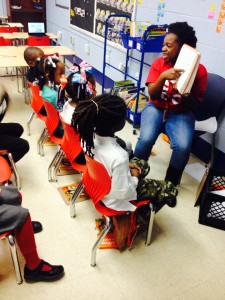 The Teachers: Teachers choose charter schools because these schools help them avoid the frustrations of constant bureaucracy. In addition to hiring the same certified teachers as traditional public schools, charter schools can hire qualified individuals that often have significant professional experience in their subject area, but may not be traditionally credentialed. This allows many charter schools to offer an education infused with real-world experience.
The Teachers: Teachers choose charter schools because these schools help them avoid the frustrations of constant bureaucracy. In addition to hiring the same certified teachers as traditional public schools, charter schools can hire qualified individuals that often have significant professional experience in their subject area, but may not be traditionally credentialed. This allows many charter schools to offer an education infused with real-world experience.
The Authorizers: The role of the charter school authorizer is to first approve charter applications and then monitor the schools to ensure success. The more organized and active an authorizer is, the more likely problems within individual charter schools will be uncovered and fixed early. Authorizers are ultimately responsible for the operational and educational integrity of each charter school they sponsor and for closing any that fail to function responsibly. Depending on the state charter school law, authorizers can be local school boards, state boards of education, state universities, state departments of education, or separate independent entities created by law that have as their sole duty sponsoring and overseeing charter schools in the state.
How Are Charter Schools Funded?
Charter schools are public schools, and are normally funded by state and local tax dollars but rarely in parity with other public schools. The funding formula for charter schools varies state to state and is typically outlined in the state’s charter law.The ways and amounts at which charters are funded compared to their district counterparts differ dramatically in an individual state and even in individual communities within a state. Nationwide, on average, charter schools receive 20 percent less per-pupil funding than their district counterparts and in some cases as much as 60 percent! To learn how your state funds charter schools visit the Parent Power Index!
The 2020 University of Arkansas publication “Charter School Funding: Inequity Surges in the Cities” exposed significant funding gaps between charter and district schools in cities across the nation. Researchers found that charter schools in the 18 cities studied receive an average 33% less total annual funding than district schools. The report states “a lack of local education funding was most responsible for the funding gap. On average, students in charter schools obtained $7,491 less in local funding than their traditional counterparts, a discrepancy of 68 percent.”
Unlike traditional district schools, most charter schools do not receive funding to cover the cost of securing a facility. Traditional public schools that convert to charter schools begin with established capital, namely the school and its facilities. A few states provide start-up grants for new charter schools, and some are able to take over available unused district space, but most must rely on other, independent means.
There are also federal grants available through the U.S. Department of Education for charter schools. “The Charter Schools Program (CSP) is the nation’s only source of dedicated federal funding for the creation of public charter schools. Read more on how charters do more with less, by the National Alliance for Public Charter Schools.
Facilities and Other Start-Up and Capital Costs: Many charter schools improvise by converting spaces such as rented retail facilities, former churches, lofts and warehouses into classroom, cafeteria, assembly and gym space, supplemented by the local YMCA, the public library and park, and the diner down the street. Once a charter school is more established it can acquire loans to move to a more suitable or permanent facility. State legislation and loan agencies are beginning to tackle this problem by providing start-up funding and providing charter schools with the information needed to obtain favorable loans.
The same is true of charter capital needs beyond bricks and mortar. School founders have managed on an ad hoc basis with the help of private funds or alternative credit routes, and especially the sweat equity of enthusiastic volunteers, parents, and local professionals. As the charter concept has become more recognized and successful, banks and corporations have developed ways to provide capital to charter schools at favorable rates.
Operational costs: Charter schools receive a portion of state and district operating funds, which are generally based on student enrollment counts. The portion is determined by the state legislation, and, in some states, is negotiated in the charter contract. A state’s charter legislation can determine that a percentage or up to a percentage of operating funds follows the students, but the actual acquisition of that funding falls upon charter school operators — sometimes no small task.
Categorical aid: Categorical federal education grant funds are also significant in operational expenses. These funds generally follow one of two routes before reaching schools: (1) either distributed directly by the U.S. Department of Education through its own application process, or (2) channeled through state education agencies that then distribute the funds in a variety of ways. Typically, state agencies distribute funds based on whether a charter school is recognized as its own local education authority or not. If it is recognized as such, charter schools may receive the money directly, rather than through the school district. The route is ultimately determined by the state legislation.
How Do Charter Schools Impact The Public School System?
The “Ripple” Effect: Traditional public school districts often view charter schools as a threat, but time has shown that these innovative schools often have an enormous impact and can serve a valuable teaching role. Over time, charter schools have become examples of “best-practices” regarding everything from curriculum to staffing to teacher retention. The attitudes of leading administrators in the conventional public school system are also changing. Instead of viewing charter schools as nuisances, many realize the need for the improvement spurred by charter schools.
Research has shown that charter schools have a “ripple effect” on other schools. Pressure brought to bear on traditional schools causes them to do more and do it better. A few examples:
Do Charter Schools Work?
Yes! Many studies reveal that charter schools are improving student outcomes. For more research on charter school achievement see here. Some highlights:

For further information, please be sure to visit CER’s Parent Power! Index list of state organizations and resources.
Also check out CER’s research and reports:
What are charter schools?
Charter schools are public schools, open by choice, free from most rules and regulations that hamper traditional public schools and held accountable for results.
Since 1991, when charter schools were first established in Minnesota, the principle has remained the same — increased operational autonomy in exchange for increased accountability for outcomes. This freedom to innovate allows academically excellent charter schools to flourish.
As of 2022, there were more than 7,800 charter schools across the country with more than 3.7 million students, with demand higher everywhere they are located. Forty-six states, including Washington, D.C. have charter school laws. West Virginia enacted the most recent law in 2019. All charter laws are not created equal, however, and in fact, many are so flawed that they allow for only minimal opportunity for parents.
For a complete assessment and explanation of charter school laws and where each state ranks, see the Parent Power! Index and National Charter School Laws Rankings & Scorecard- 2022.
How Do Charter Schools Differ from Traditional District Public Schools?
Charter schools operate on three basic principles:
Choice: Charter schools give families an opportunity to pick the school most suitable for their child’s educational well-being. Teachers choose to create and work at schools where they can directly shape the learning environment for their students and themselves in innovative ways. Likewise, charter authorizers choose to sponsor schools that are likely to best serve the needs of the students in a particular community.
Innovation: One of the reasons parents and students seek charters is because, when they work, they offer options that are distinct from those found in most traditional school districts. Charters have the flexibility to innovate in many ways: from developing unique approaches to teacher training to pioneering tools for personalized learning, many innovations that are now accepted as common were born in the charter sector.
Accountability: Charter schools must meet the student achievement goals established by their charter contracts and must also meet rigorous fiscal and managerial standards. If a charter school cannot perform up to the established standards, it will be closed.
Freedom: While charter schools must adhere to the same major laws and regulations as all other public schools, they are freed from the red tape that often diverts a school’s energy and resources away from educational excellence. Instead of constantly jumping through procedural hoops, charter school leaders can focus on setting and reaching high academic standards for their students.
Some charter school programs focus on the basics — reading, writing, and the traditional school subjects with which some students struggle. Other schools have special arts or music programs. Some charters look just like traditional public schools, and some serve a particular community. Some are dropout prevention programs, adult education programs, online programs, charters that serve day care needs, and charters that work with children who want to go to college.
What does Charter School Enrollment Look Like?
There are more than 7,800 charter schools across the country with more than 3.7 million students attending, with demand higher everywhere they are located. Over time, demand for charters has skyrocketed, despite setbacks deriving from weak charter school policies, overregulation, and false perceptions of charter schools promulgated by opponents of school choice.
Over one million students currently sit on charter school waitlists– because many states place caps on the number of charter schools that can exist, charter schools often have more applicants than spaces available. When this happens, charters admit students via lotteries. Lotteries ensure that students are randomly selected and, in this way, that charter schools cannot “cream” students, especially those that may be considered “easier” to educate, or who may be better equipped to perform well academically. Unfortunately, however, in places where demand for charter schools is very high, there are large numbers of students who do not win lotteries (these students number in the tens of thousands in some cities).19 For many students and families, failure to “win” a charter school seat is a painful experience, tantamount to being stripped of a meaningful choice and the opportunity to access a high quality education.
CER’s research and surveys have found that on average, charter schools across the country serve more black, Hispanic, and low-income students than their traditional public school counterparts. Demographic groups that have traditionally not had access to high quality public schools are more likely than others to seek a charter school education. Data suggests that minority students are more likely to take advantage of charter school options, and in some areas (mostly urban centers) minority students are attending charter schools in concentrated numbers, looking for better educational options. For more information, read CER’s Just the Facts: Success, Innovation, and Opportunity in Charter Schools.
In New York City, about 41% of city charter students, or nearly 58,000, are black, with another 49% Hispanic. By comparison, in city public schools, nearly 72% of students were considered disadvantaged in 2021-22. Nearly 24.5% were black, 41% Hispanic, 16.6% Asian and 14.7% white.
Why Are Charter Schools So Popular?
Quality Education: The primary reason for the existence of charter schools is to make sure every child has access to a quality education. With the freedom and choice to do so, charters set higher standards and must meet them to stay in business. Most traditional district public schools stay in business no matter how poorly they perform. Charters are one of America’s tickets to a higher-quality school system.
Focus on the kids: Perhaps one of the most important features of charter schools is that they are set up around the needs of children, not around the needs of adults. The focus should always be on the kids, and programs should be designed to help children succeed, no matter what it takes.
Safer, stronger communities: Charter schools typically engage local businesses and other organizations to help provide resources and services to the school and its families. Many charter schools create a community hub, whether it is turning an inner-city ghetto into a bustling and safer neighborhood or bringing families in rural America together, charter schools have a proven effect on the strength and safety of a community.
Traditional public education is deficient:The latest results in math and reading for grades 4 and 8 on the National Assessment of Education Progress (also known as “The Nation’s Report Card”) demonstrate that the vast majority of our nation’s education systems are simply failing to meet the very basic educational needs of American students. But while the nation’s overall scores were either flat or declined, In DC where a majority of students are no longer confined to their zip code and almost 50% of students are in charter schools, students showed gains in almost every category. Student proficiency has now shown steady and consistent improvement since 1996, when the District’s charter school law first went into effect.
Combined with data from states such as Arizona and Florida where a prevalence of educational options exist, the NAEP data suggests that academic proficiency scores rise where educational choices are robust.
For more information on why charter schools are so popular, read CER’s America’s Attitudes Towards Education Reform Public Support For Accountability in Schools.
How Do Charter Schools Work?
Legislation: Before you can have charter schools, you must have a state charter school law. Forty-five states and the District of Columbia have enacted charter school laws. (The five states that do not have charter school laws are Montana, Nebraska, North Dakota, South Dakota, and Vermont.)
The content of the charter law plays a large role in the relative success or failure of the charter schools that open within that state. CER has identified a number of factors that can work together to create an environment that promotes the growth and expansion of charter schools. For a complete assessment and explanation of charter school laws and where each state ranks, visit CER’s National Charter School Laws Rankings & Scorecard- 2022.
- Number of Schools & Applications: The best charter laws do not limit the number of charter schools that can operate throughout the state. They also do not limit the number of students that can attend charter schools. A poorly written law would set restrictions on the types of charter schools allowed to operate (new starts, conversions, online schools), hindering parents’ ability to choose among numerous public schools. A strong charter school law should also allow many different types of groups to apply to open and start charter schools.
- Multiple Charter Authorizers: States that permit a number of entities to authorize charter schools, or provide applicants with a binding appeals process, encourage more activity than those that vest authorizing power in a single entity, particularly if that entity is the local school board. The goal is to give parents the most options possible, and having multiple sponsors helps reach this goal. Additionally, it is important that the authorizing entities have independent power from one another to prevent creating multiple authorizers “in name only.”For more information on why multiple authorizers are important, please see our Multiple Authorizers Primer.
- Waivers & Legal Autonomy: A good charter law is one that automatically exempts charter schools from most of the school district’s laws and regulations. Of course no charter school is exempt from the most fundamental laws concerning civil rights. These waivers allow charter schools to innovate and try new learning strategies that traditional public schools cannot.
- Full Funding & Fiscal Autonomy: A charter school needs to have control of its own finances to run efficiently. The charter school’s operators know the best way to spend funds, and charter law should reflect this need. Similarly, charter schools, as public schools, are entitled to receive the same amount of funds as all other conventional public schools. Many states and districts withhold money from individual charter schools due to fees and “administrative costs,” but the best laws provide full and equal funding for all public schools.
The Founders: Qualified individuals can submit an application to open and operate a charter school. Parents, educators, museums, civic groups, business leaders, service organizations, and teachers have started charter schools in the United States. Charter schools are started when community members see an educational need and decide to actively address it.
The Board: Every charter school is required by law to have a board of directors that is ultimately responsible for what the school does. Legally, the board oversees the operations of the school and makes sure it is financially sound and follows the law. The Board also helps to create the vision for how the school should operate, and is often made up of parents of children attending the charter school.
 The Teachers: Teachers choose charter schools because these schools help them avoid the frustrations of constant bureaucracy. In addition to hiring the same certified teachers as traditional public schools, charter schools can hire qualified individuals that often have significant professional experience in their subject area, but may not be traditionally credentialed. This allows many charter schools to offer an education infused with real-world experience.
The Teachers: Teachers choose charter schools because these schools help them avoid the frustrations of constant bureaucracy. In addition to hiring the same certified teachers as traditional public schools, charter schools can hire qualified individuals that often have significant professional experience in their subject area, but may not be traditionally credentialed. This allows many charter schools to offer an education infused with real-world experience.
The Authorizers: The role of the charter school authorizer is to first approve charter applications and then monitor the schools to ensure success. The more organized and active an authorizer is, the more likely problems within individual charter schools will be uncovered and fixed early. Authorizers are ultimately responsible for the operational and educational integrity of each charter school they sponsor and for closing any that fail to function responsibly. Depending on the state charter school law, authorizers can be local school boards, state boards of education, state universities, state departments of education, or separate independent entities created by law that have as their sole duty sponsoring and overseeing charter schools in the state.
How Are Charter Schools Funded?
Charter schools are public schools, and are normally funded by state and local tax dollars but rarely in parity with other public schools. The funding formula for charter schools varies state to state and is typically outlined in the state’s charter law.The ways and amounts at which charters are funded compared to their district counterparts differ dramatically in an individual state and even in individual communities within a state. Nationwide, on average, charter schools receive 20 percent less per-pupil funding than their district counterparts and in some cases as much as 60 percent! To learn how your state funds charter schools visit the Parent Power Index!
The 2020 University of Arkansas publication “Charter School Funding: Inequity Surges in the Cities” exposed significant funding gaps between charter and district schools in cities across the nation. Researchers found that charter schools in the 18 cities studied receive an average 33% less total annual funding than district schools. The report states “a lack of local education funding was most responsible for the funding gap. On average, students in charter schools obtained $7,491 less in local funding than their traditional counterparts, a discrepancy of 68 percent.”
Unlike traditional district schools, most charter schools do not receive funding to cover the cost of securing a facility. Traditional public schools that convert to charter schools begin with established capital, namely the school and its facilities. A few states provide start-up grants for new charter schools, and some are able to take over available unused district space, but most must rely on other, independent means.
There are also federal grants available through the U.S. Department of Education for charter schools. “The Charter Schools Program (CSP) is the nation’s only source of dedicated federal funding for the creation of public charter schools. Read more on how charters do more with less, by the National Alliance for Public Charter Schools.
Facilities and Other Start-Up and Capital Costs: Many charter schools improvise by converting spaces such as rented retail facilities, former churches, lofts and warehouses into classroom, cafeteria, assembly and gym space, supplemented by the local YMCA, the public library and park, and the diner down the street. Once a charter school is more established it can acquire loans to move to a more suitable or permanent facility. State legislation and loan agencies are beginning to tackle this problem by providing start-up funding and providing charter schools with the information needed to obtain favorable loans.
The same is true of charter capital needs beyond bricks and mortar. School founders have managed on an ad hoc basis with the help of private funds or alternative credit routes, and especially the sweat equity of enthusiastic volunteers, parents, and local professionals. As the charter concept has become more recognized and successful, banks and corporations have developed ways to provide capital to charter schools at favorable rates.
Operational costs: Charter schools receive a portion of state and district operating funds, which are generally based on student enrollment counts. The portion is determined by the state legislation, and, in some states, is negotiated in the charter contract. A state’s charter legislation can determine that a percentage or up to a percentage of operating funds follows the students, but the actual acquisition of that funding falls upon charter school operators — sometimes no small task.
Categorical aid: Categorical federal education grant funds are also significant in operational expenses. These funds generally follow one of two routes before reaching schools: (1) either distributed directly by the U.S. Department of Education through its own application process, or (2) channeled through state education agencies that then distribute the funds in a variety of ways. Typically, state agencies distribute funds based on whether a charter school is recognized as its own local education authority or not. If it is recognized as such, charter schools may receive the money directly, rather than through the school district. The route is ultimately determined by the state legislation.
How Do Charter Schools Impact The Public School System?
The “Ripple” Effect: Traditional public school districts often view charter schools as a threat, but time has shown that these innovative schools often have an enormous impact and can serve a valuable teaching role. Over time, charter schools have become examples of “best-practices” regarding everything from curriculum to staffing to teacher retention. The attitudes of leading administrators in the conventional public school system are also changing. Instead of viewing charter schools as nuisances, many realize the need for the improvement spurred by charter schools.
Research has shown that charter schools have a “ripple effect” on other schools. Pressure brought to bear on traditional schools causes them to do more and do it better. A few examples:
- Despite their size and scope, charter schools were faster to respond and more likely to keep educating after Covid-19’s arrival than traditional public schools. Many traditional public schools looked to charters as an example for flexibility & innovation.
- In New York City, research over a 14 year period by Temple University professor Sarah Cordes demonstrated that “exposure to charter schools significantly increased student performance at nearby traditional public schools. The effects increased with proximity to the closest charter school; students at traditional public schools co-located with charters experienced the greatest positive impacts.”
- The 2020 report “Charter School Entry, Teacher Freedom, and Student Performance” explores whether the impact of teacher freedom to innovate in charter schools affect traditional schools nearby: “for teacher freedom our results show that on average traditional public school students in states with charter school laws that allow teacher autonomy outperform those that do not.”
Do Charter Schools Work?
Yes! Many studies reveal that charter schools are improving student outcomes. For more research on charter school achievement see here. Some highlights:

- In a 2021 study, The Long-term Effects of Charter School Exposure on Education and Health Behaviors, there exists evidence that public charter schools increase educational attainment and reduce unhealthy behaviors.
- According to the EdChoice 2020 Schooling in America Survey, “Parents with children in charter schools or homeschooling are more likely to report their children are much less stressed than public district school parents” during the pandemic.
- The University of Arkansas (April 2019) reports A Good Investment: The Updated Productivity of Public Charter Schools in Eight U.S. Cities finds that “lifetime earnings for students attending charter schools are four- to six-times the amount of money invested in their education. On average, they’ll reap .37 for every dollar in charter schools and .41 for every dollar in traditional public schools.”
- According to the Charter Schools Bright Spot in Disturbing Schools Report, when examining 2019 NAEP scores, “Milwaukee’s charter schools are performing much better than traditional Milwaukee Public Schools (MPS) district schools. In 4th grade math, Milwaukee charter schools scored 235, close to the state average for 4th graders of 242. MPS scored a 212.”
- U.S. News reported in 2020 that 11% of the top 25% of public high schools are charters; they also found that charters and magnet schools also claim 8 of the top 10 spots in the overall national rankings.
- In 2019, Florida DOE’s Annual Charter School Performance Report demonstrated that charter schools consistently outperformed students in traditional public schools in multiple categories. Education Commissioner Richard Corcoran said, “There is simply no denying that choice works, particularly for minority and low-income students. These results represent hundreds of thousands of Florida families who were empowered to make the best education decisions for their children and are reaping the benefits.”
- Charter schools have been more successful at closing racial achievement gaps than their district counterparts. In 2020, a nationwide study on achievement trends over a 12-year timespan showed that charter students made greater improvements in math and reading than district students on national achievement tests. “The difference in the trends in the two sectors amounts to nearly an additional half-year’s worth of learning. The biggest gains are for African Americans and for students of low socioeconomic status attending charter schools.”
For further information, please be sure to visit CER’s Parent Power! Index list of state organizations and resources.
Also check out CER’s research and reports:
- June 2019: The Path to Charter Schools A brief but critical history of the charter school idea. “The Path To Charter Schools” is a first-hand account that corrects the myths and misinformation concerning charters circulating in the public eye.
- October 2019: Expanding Education Innovation And Opportunity In Rural America With increasing scrutiny of rural America and its lagging educational outcomes, it’s time to consider new, innovative approaches to improving and expanding education opportunity in rural communities. That is the conclusion of a new whitepaper issued by the Center for Education Reform (CER), which offers several vital “ingredients” needed to transform education to serve all populations in rural America.
- Voices Of Color, Voices For Opportunity A series of opinions by African-American leaders engaged in the battle for educational opportunity in their communities. Given the movement for systemic change and an end to racism once and for all we are resurfacing these voices who came together to stand up for equal access to opportunity for students of color.











 GROUNDHOG DAY IS YEAR-ROUND FOR THE UNIONS. Failing kids don’t matter to them…failing schools don’t matter to them. It’s the same day every day for the unions. But our kids can’t afford another “continuous loop” groundhog day of 2020’s disastrous loss of learning in 2021. They need an immediate start to school…not more “groundhog” excuses from the unions.
GROUNDHOG DAY IS YEAR-ROUND FOR THE UNIONS. Failing kids don’t matter to them…failing schools don’t matter to them. It’s the same day every day for the unions. But our kids can’t afford another “continuous loop” groundhog day of 2020’s disastrous loss of learning in 2021. They need an immediate start to school…not more “groundhog” excuses from the unions.
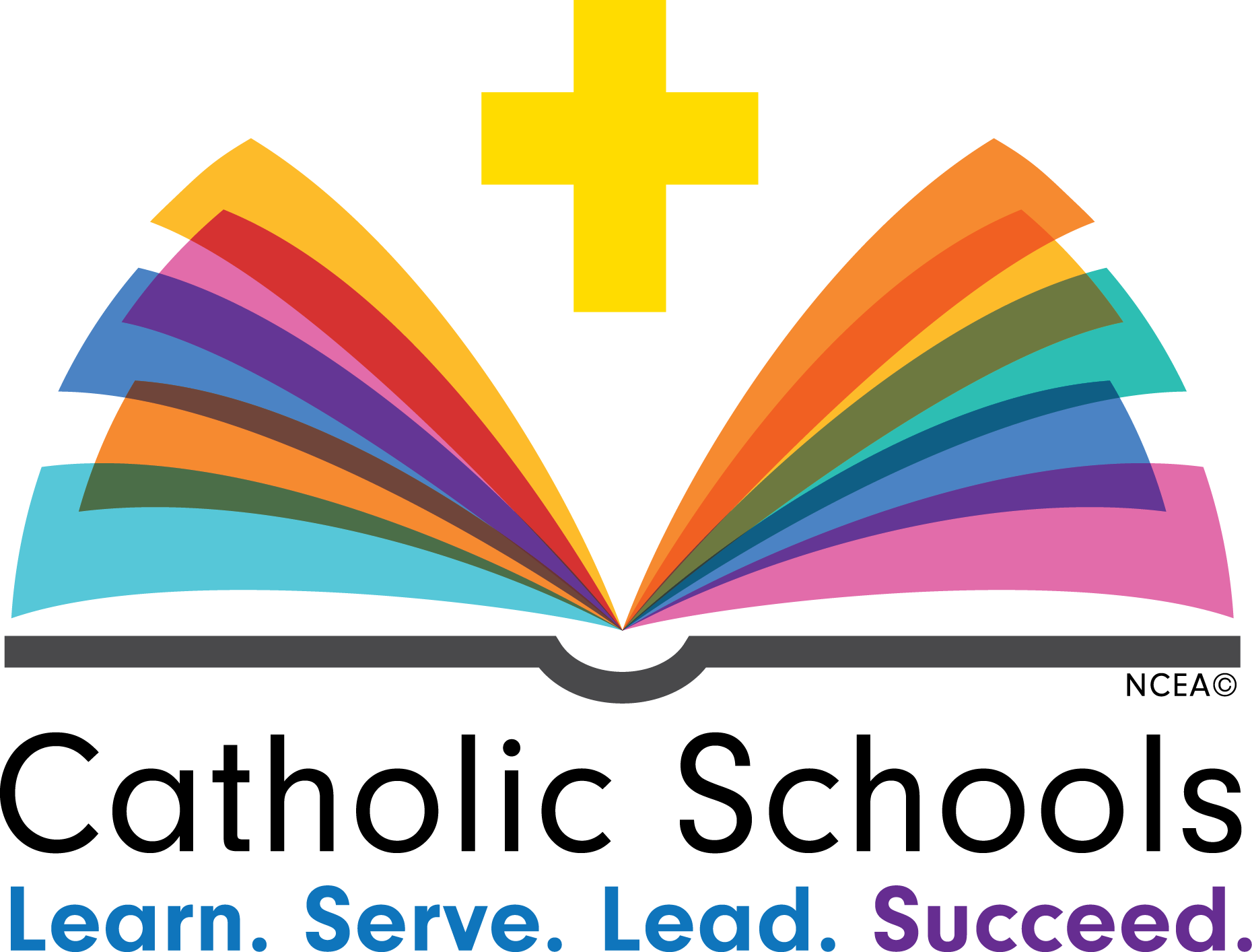 CATHOLIC SCHOOLS WEEK. We should be celebrating how many are actually open compared to the bulk of schools around the country. Their success should be recognized by the man they helped educate, who sits in the Oval Office. The test for the President as Jeanne Allen posed in
CATHOLIC SCHOOLS WEEK. We should be celebrating how many are actually open compared to the bulk of schools around the country. Their success should be recognized by the man they helped educate, who sits in the Oval Office. The test for the President as Jeanne Allen posed in 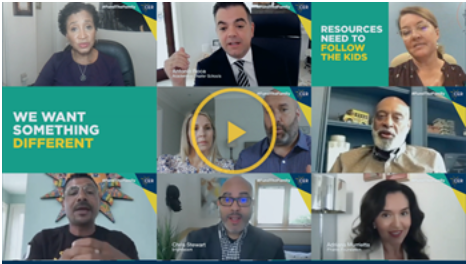
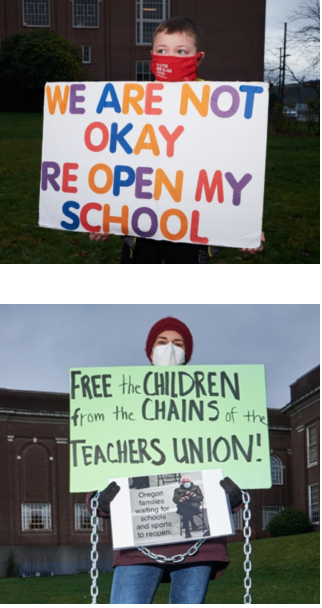 YOU CAN’T MAKE THIS STUFF UP. Actually, we wish we had made up the fact that
YOU CAN’T MAKE THIS STUFF UP. Actually, we wish we had made up the fact that 
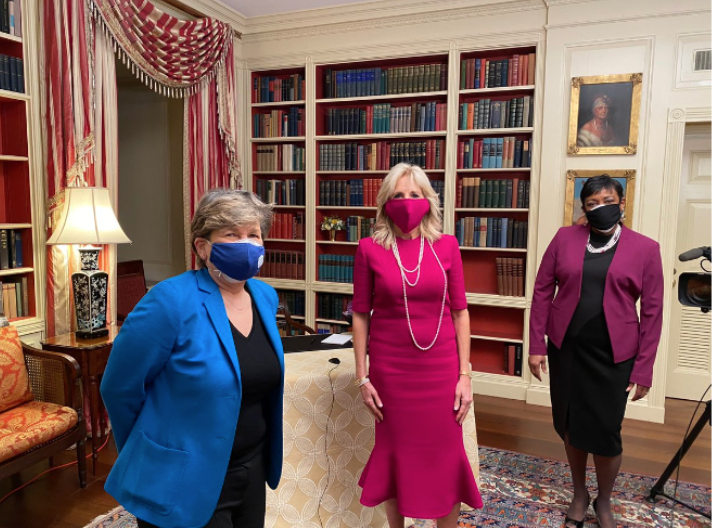 A PICTURE TELLS A THOUSAND WORDS. This pic with the First Lady and both union bosses, from
A PICTURE TELLS A THOUSAND WORDS. This pic with the First Lady and both union bosses, from 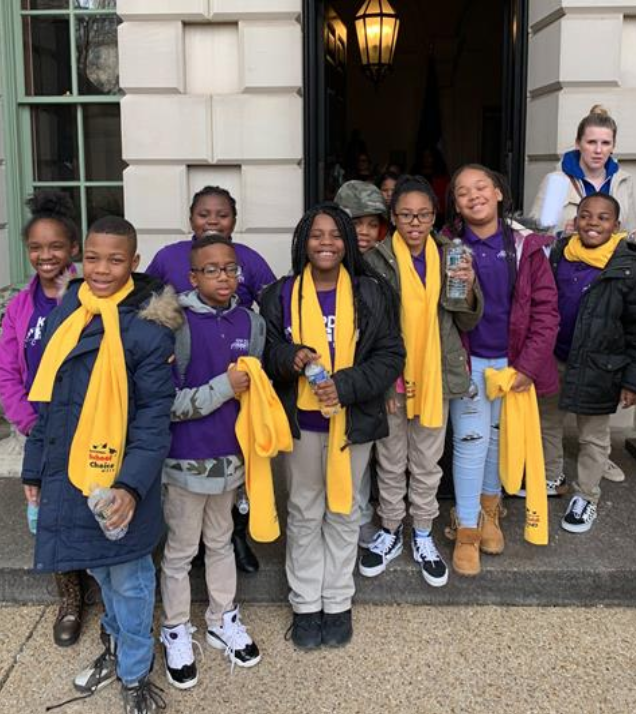 in education guided by one’s own choice, not one’s zip code. This week marks the world’s largest celebration of opportunity in education, complete with
in education guided by one’s own choice, not one’s zip code. This week marks the world’s largest celebration of opportunity in education, complete with 
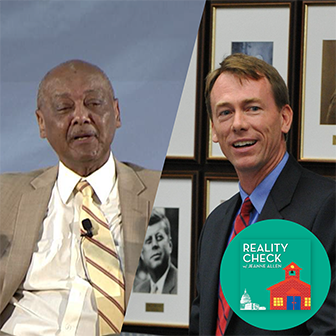 TEACH HISTORY, SAVE DEMOCRACY? The latest Reality Check w/Jeanne Allen features an in-depth discussion of the issues surrounding how and why teaching civics and history may hold the key to saving our Democratic Republic. As scholar Jeffrey Sikkenga of
TEACH HISTORY, SAVE DEMOCRACY? The latest Reality Check w/Jeanne Allen features an in-depth discussion of the issues surrounding how and why teaching civics and history may hold the key to saving our Democratic Republic. As scholar Jeffrey Sikkenga of 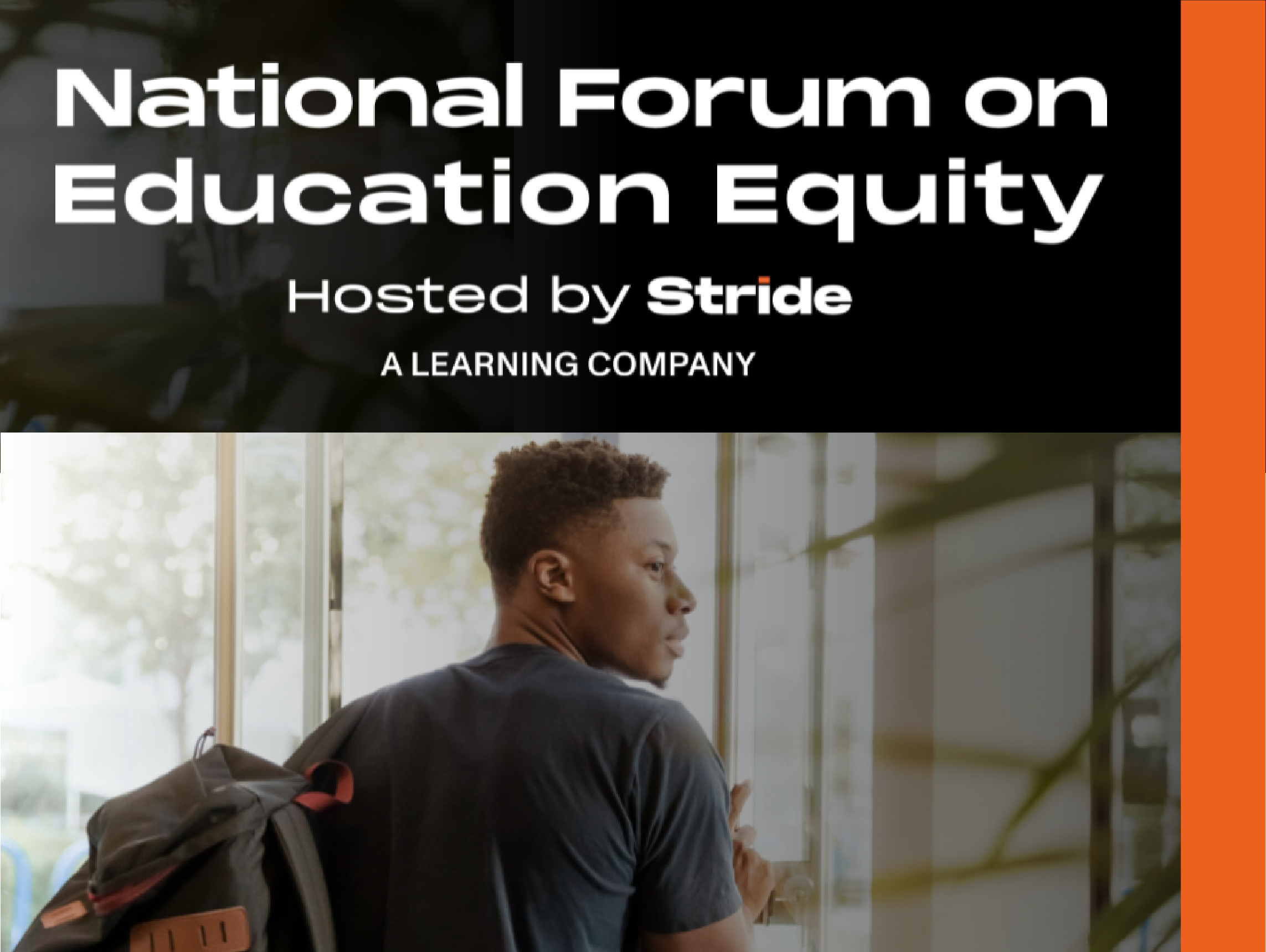
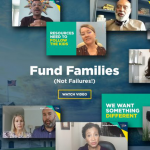
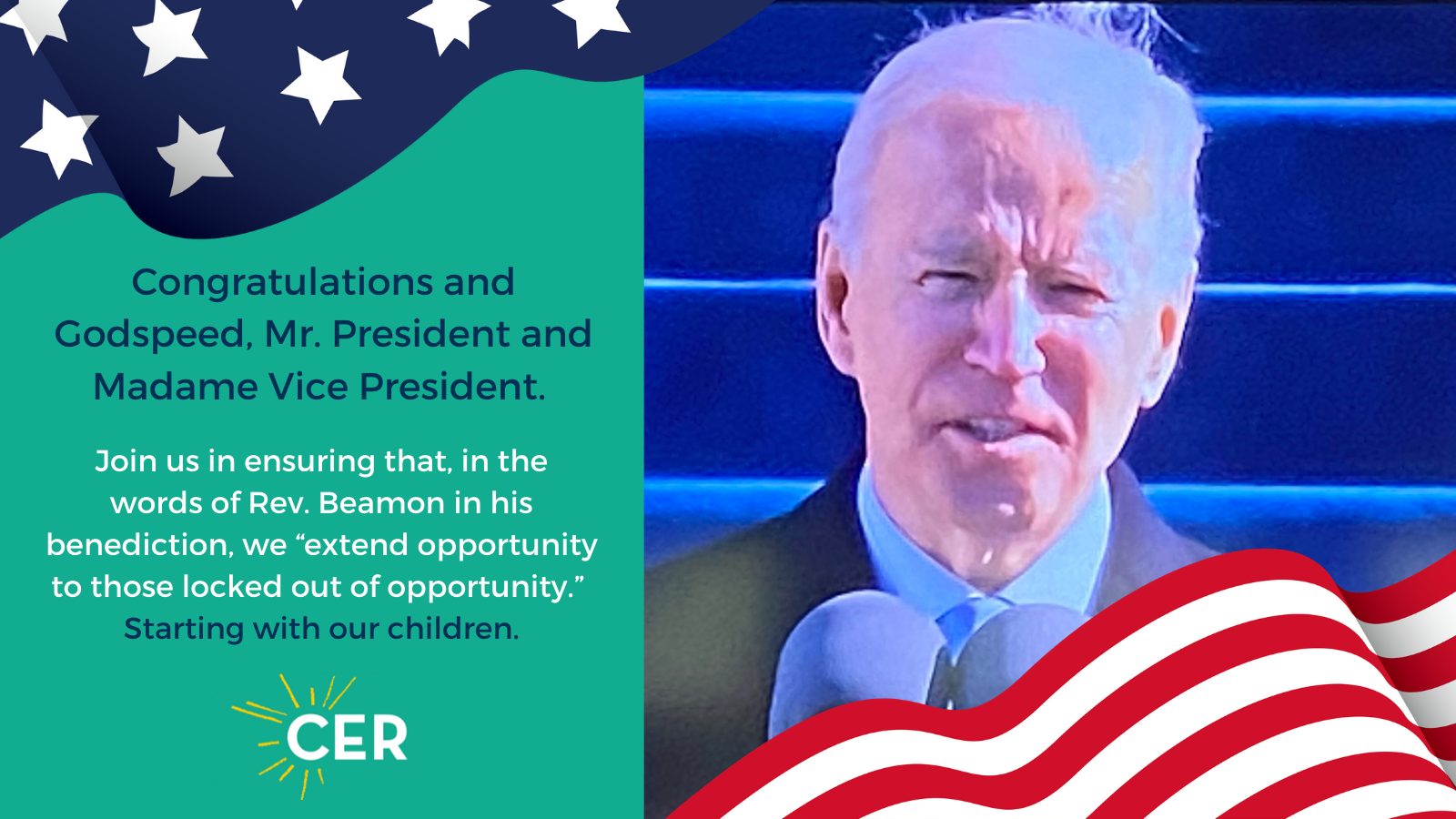
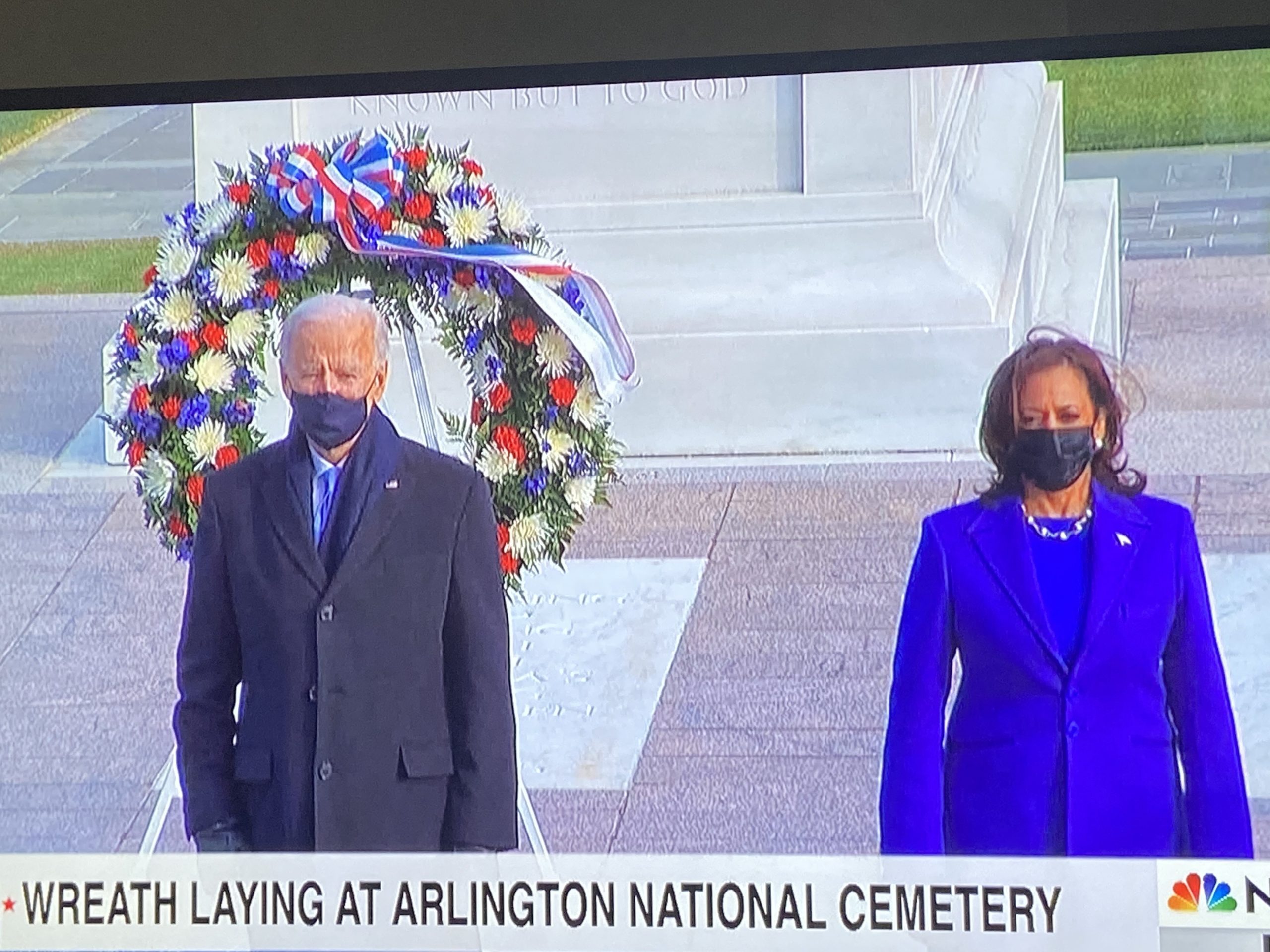 WOMEN MAKING HISTORY. Kamala Harris is just the latest in a nation of women to “make history.” President Biden in his speech today talked about the history made 108 years ago when women marched along the inaugural parade route to the Capitol to demand the right to vote. Our nation’s first three first ladies also made history. They instituted a lot of the inaugural traditions observed today, supported their husbands in their work and even saved documents from the British as they burned the White House! In helping teachers and students prepare to learn about transfers of power and what goes along with it, CER’s
WOMEN MAKING HISTORY. Kamala Harris is just the latest in a nation of women to “make history.” President Biden in his speech today talked about the history made 108 years ago when women marched along the inaugural parade route to the Capitol to demand the right to vote. Our nation’s first three first ladies also made history. They instituted a lot of the inaugural traditions observed today, supported their husbands in their work and even saved documents from the British as they burned the White House! In helping teachers and students prepare to learn about transfers of power and what goes along with it, CER’s 
 OUR BETTER ANGELS. Hatred is borne of ignorance and ignorance festers when we fail to impart knowledge. By the time our students reach adulthood, they
OUR BETTER ANGELS. Hatred is borne of ignorance and ignorance festers when we fail to impart knowledge. By the time our students reach adulthood, they 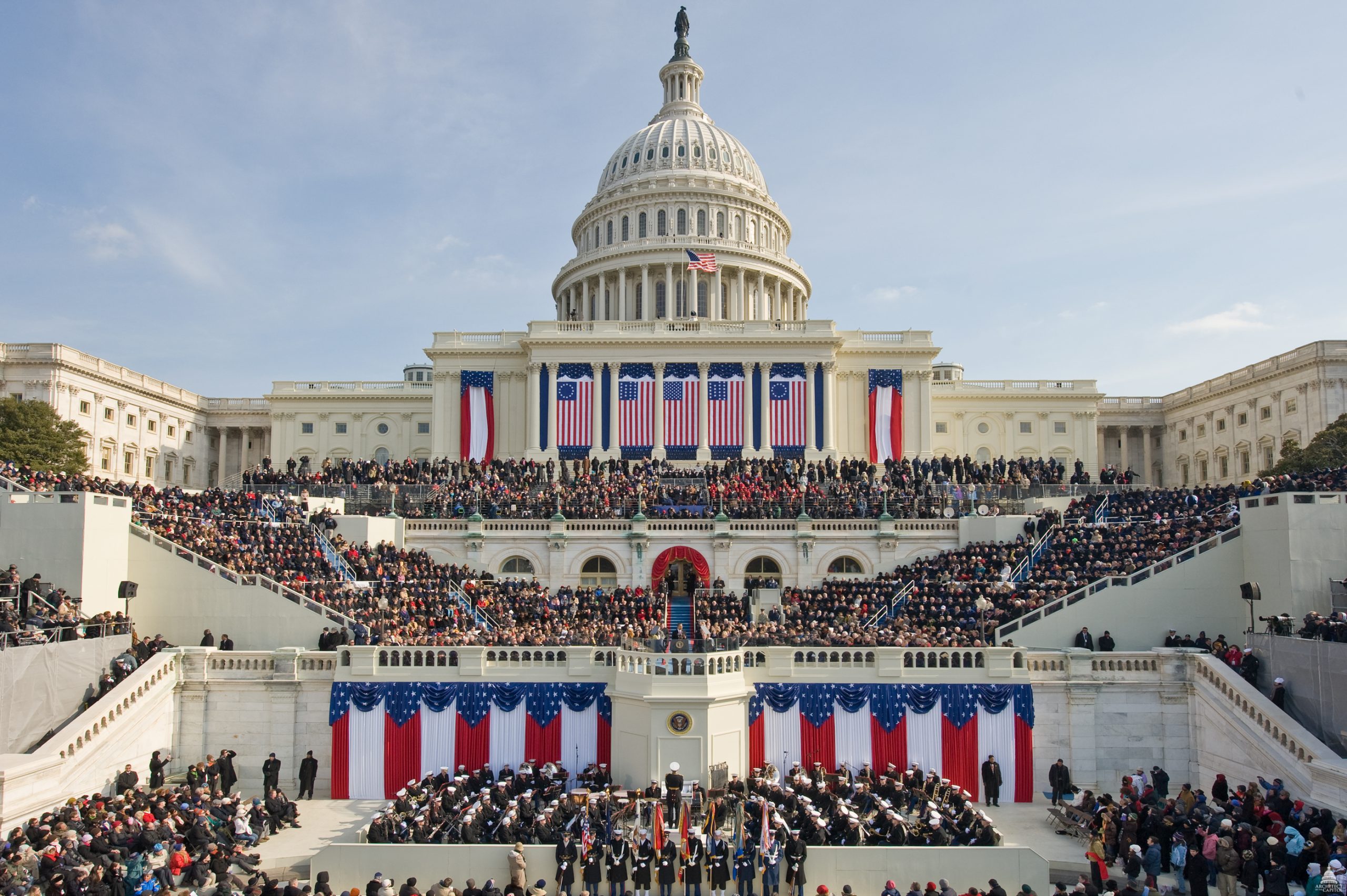 INAUGURATIONS. Tune in today, Wednesday, January 13th at 4 pm EDT for the final session of CER’s Why America? 2020 Toward a More Perfect Union program
INAUGURATIONS. Tune in today, Wednesday, January 13th at 4 pm EDT for the final session of CER’s Why America? 2020 Toward a More Perfect Union program  OPPORTUNITY = FREEDOM. “I favor radical decentralization,” said
OPPORTUNITY = FREEDOM. “I favor radical decentralization,” said 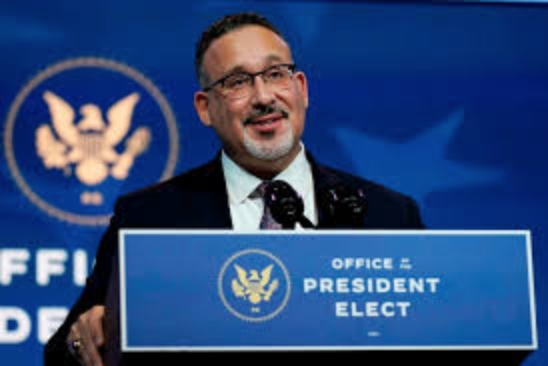 HOPE FOR THE FUTURE. The nomination of Miguel Cardona as Education Secretary, is, as we’ve said both
HOPE FOR THE FUTURE. The nomination of Miguel Cardona as Education Secretary, is, as we’ve said both 

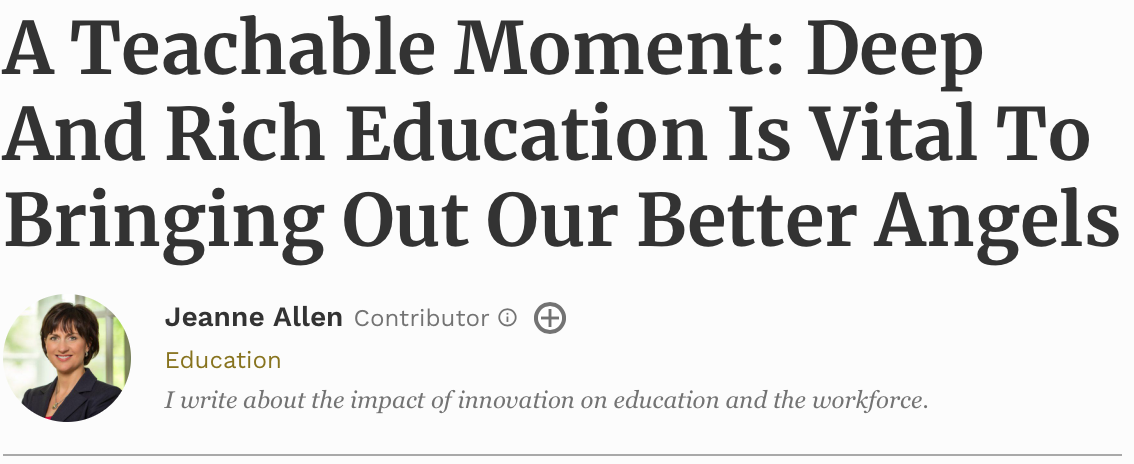


School Cancellations Continue To Hurt Kids, Pushing More Parents To DIY Options
By Jeanne Allen, Founder and CEO of CER
“Chicago cancels in-person classes Wednesday as teachers announce walkout”
“New CDC Research Backs Biden Push for In-Person Schooling”
“Biden Backs Chicago Teachers Refusing to Return to School”
“De Blasio Vows NYC Schools Will Reopen in September at ‘Full Strength’”
These are just a few of the headlines on school reopening that are fueling the debate. The articles and reports of schools remaining closed, trying to reopen, and of the groups —mostly teachers unions— fighting the reopening are in the hundreds weekly. The reality is we simply don’t know, and each day the goal line is moved.
The battle is taking its toll on the nation’s youth, and on their education.
A massive study on 50,000 students in 18 California districts confirmed that students who were already behind are hardest hit.
As early as July, Child Trends urged policymakers and education leaders to address the “the social, emotional, and behavioral effects of the ongoing pandemic.” But without the ability to bring students together, such hopes were lost for most.
The result as of late has been a string of reports about the increasing isolation among students, and even instances of suicide, impacts for many students who have no learning community around them.
The cruel irony of this tragedy is that isolation need not be the default response of school closures. Within several weeks of school closings, schools and families were creating their own small learning communities for students. Akin to the DIY craze in cultural areas of life, an explosion of parent pods and micro-schools, both organic and well developed programs, have been an apt, and often better, substitute.
“‘The benefits of micro-schools are a safe, energized, social environment where kids can love learning,’ says Kelly Smith, founder and CEO of micro-school company Prenda. He cites flexibility of schedules—families can choose when their micro-school meets—and personalized, more engaging education as big perks.”
In fact, the evidence has been growing for nearly a decade that personalized learning can be more effective than the traditional classroom, permitting students to move at their own pace, moving forward only when competency in one area is achieved. Reports of the progress students are making in pods – regardless of socioeconomic status – is a contrast to traditional education.
While many micro-school organizations report dramatic increases in “customers,” the vast majority of students remain stuck with poor or inequitable remote education as a proxy for school. This fact and the politics surrounding reopening schools remains front page news, but the coverage of the micro-schools is predominantly relegated to the education blogs and press. The result is that most parents whose children need additional support are unaware of this option.
Consider that with very little publicity or promotion at all:
“We had no idea in a few short months we’d be working furiously to support tens of millions of new first-time homeschoolers,” said the founder of Primer last fall.
What do these institutions do that traditional schools cannot?
First, they offer ‘permissionless’ options to families. These schools don’t need to get approved or sanctioned to teach and operate.
Second, they provide immediate, measurable outcomes. Micro-schools employ commonly accepted and proven methods of assessment, both to monitor and support the flow of learning and as a signal for traditional education systems if and when a student may return.
Third, they are entirely customizable. They can be organized by weeks, months, or by program. They can be supplemental or full school models.
The only impediment to expansive growth may be cost. Parents pay what are typically nominal fees for access to curriculum and hardware. Costs can vary widely, Increasingly, philanthropy is supporting their establishment. For example, the National Parents Union has distributed grants to parents who cannot afford to buy the programs needed to organize their own pods. Several other philanthropic efforts are supporting families most in need.
There are several publicly-funded routes too that will likely see expansion in the near future. Partnerships with charter schools in Arizona, for example, have made it possible for the Black Mothers Forum to form several pods for parents whose students were not being well-served by Phoenix area schools. That’s good news for parents who cannot afford to pay for education on their own, especially until federal and state policymakers make provisions for providing resources to families directly.
“What’s really exciting about this movement is this could potentially lead to funding for micro-schools from our school districts, from our state governments, and from the federal government,” he said. “And if there’s funding for micro-schools, just like there’s funding for public school or funding for charter schools, then, suddenly, you know, everyone gets access to a micro-school.,” Wonderschool Founder Chris Bennett told Forbes contributor Michael Horn.
That idea may not be far off. New entities like Portal Schools, which launches in the Fall, combine high school and higher education in a five-year dual degree program and partners with corporations to place students on their “campus.” This allows a simultaneous school and career training experience that may make the current model of high school obsolete. With a world of work awaiting older students and lack of substantive access to education to help them get to and through college, Portal’s model is helping to redefine the high school experience, for good.
Many educators who’ve long believed the system has failed to educate most children relish the opportunity to rethink education, and are expanding on concepts they have long worked toward.
“There is a narrative in America that assumes schooling is learning,” educators Kelly Niccolls and Rebecca Midles wrote recently in Getting Smart. “It is not.” There is an assumption that since students are not sitting in classrooms and buildings they are not learning and “are behind.”
But it’s not students who are failing they argue, but “the system is failing more now than it did in the past.” They argue convincingly that “the static outcomes for what we learned in schooling a year ago, no longer apply. Our human ecosystem has shifted. We must let go of standardization and turn towards personalization and actualization. Our ability to do this well will be a turning point as the entire world shifts into a new way of being, post-pandemic.”
They are right. There is just no dearth of innovative options available to ensure teaching and learning are occurring regardless of whether school systems are opened or closed. The antagonistic relationships between labor and management that is turning off parents and keeping students from getting what they need can be bypassed entirely.
The pandemic has done for the globe what no amount of research or advocacy has been able to accomplish – the recognition that parents can indeed drive the education of their kids and with the proper innovations available, education can and will happen anywhere, if we give parents the tools and the resources to find it.
Founded in 1993, the Center for Education Reform aims to expand educational opportunities that lead to improved economic outcomes for all Americans — particularly our youth — ensuring that conditions are ripe for innovation, freedom and flexibility throughout U.S. education.